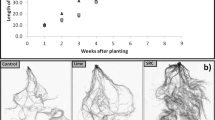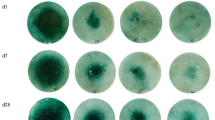Abstract
Soil samples were collected from 20 locations from the south western part of Western Australia and incubated at 25 °C for 60 days without or with finely ground granite powder at a rate of 20 g kg−1 soil, equivalent to about 20 t ha−1. Electrical conductivity and exchangeable Na, Ca and Mg were not significantly affected by granite application for most soils. Conversely, among the 20 soils studied, nine exhibited a significant increase in exchangeable K (atp<0.01) due to granite application. Six of them showed a consistent increase in soil pH as measured in a CaCl2 extract, corresponding to less than 0.26 pH units. The concomitant increase in exchangeable K due to granite application ranged between 10 and 390%. However, in absolute value it amounted to less than 0.07 cmol K kg−1 soil, suggesting that a maximum of 59 g kg−1 of the applied granite dissolved during the course of this incubation experiment. One of the most granite responsive soils was used for a pot experiment conducted with wheat grown for 88 days in a glasshouse. In this experiment, the soil was either untreated (control) or mixed with either granite or diorite powders at six different rates of application. The wheat biomass and cation contents in plant tissue were not significantly affected by the application of diorite at any rate of application. Conversely, for the granite-treated soil a significant increase in wheat biomass was encountered for rates larger than 2.5 g kg−1 soil. Since a significant increase in K content was obtained at the same rates of application it was concluded that the positive response of wheat growth to granite application was due to potassium supplied by granite dissolution. The use of granite powder as a potential K fertilizer thus needs further attention even though its efficiency as compared to a soluble fertilizer would almost certainly be poor.
Similar content being viewed by others
References
Baerug R (1991) Rock powder as a source of nutrients to different crops. I. The magnesium effect of rock powder. Norsk landbruksforkning 5: 183–188
Blum WEH, Herbinger B, Mentler A, Ottner F, Pollak M, Unger E and Wenzel WW (1989a) Zur Verwendung von Gesteinsmehlen in der Landwirtschaft. I. Chemisch-mineralogische Zusammensetzung und Eignung von Gesteinsmehlen als Bodenverbesserungsmittel. Z Pflanzenern Bodenk 152: 427–430
Blum WEH, Herbinger B, Mentler A, Ottner F, Pollak M, Unger E and Wenzel WW (1989b) Zur Verwendung von Gesteinsmehlen in der Landwirtschaft. II. Wirkung von Gesteinsmehlen als Düngemittel. Z Pflanzenern Bodenk 152: 421–425
Bockman OC, Kaarstad O, Lie OH and Richards I (1990) Agriculture and Fertilizers. Fertilizers in Perspective, Norway: Norsk Hydro a.s. Publish., 245 pp.
Fanning DS, Keramidas VZ and El-Desoky MA (1989) Micas. In: Dixon JB and Weed SB (eds) Minerals in Soil Environment, pp 551–634. Madison, Wisc.: Soil Science Society of America
Fragstein P von, Pertl W and Vogtmann H (1988) Verwitterungsverhalten silikatischer Gesteinsmehle unter Laborbedingungen. Z Pflanzenern Bodenk 151: 141–146
Gilkes RJ, Young RC and Quirk JP (1973) Artificial weathering of oxidized biotite: I. Potassium removal by sodium chloride and sodium tetraphenylboron solutions. Soil Sci Soc Amer Proc 37: 25–28
Gillman GP (1980) The effect of crushed basalt scoria on the cation exchange properties of a highly weathered soil. Soil Sci Soc Am J 44: 465–468
Goldich SS (1938) A study in rock weathering. J Geol 46: 17–58
Hinsinger P and Jaillard B (1993) Root-induced release of interlayer potassium and vermiculitization of phlogopite as related to potassium depletion in the rhizosphere of ryegrass. J. Soil Sci. 44: 525–534
Hughes JC and Gilkes RJ (1994) Rock phosphate dissolution and bicarbonate-soluble P in some soils from South-Western Australia. Aust J Soil Res 32: 767–779
Kahnt G, Pfleiderer H and Hijazi L A (1986) Wirkungen meliorativer Gaben von Gesteinsmehlen und Gesteinssanden auf das Wachstum verschiedener landwirtschaftlicher Kulturpflanzen sowie auf physikalische Kennwerte eines Sandbodens und eines Tonbodens. J Agronomy Crop Sci 157: 169–180
Leonardos OH, Fyfe WS and Kronberg BI (1987) The use of ground rocks in laterite systems: an improvement to the use of conventional soluble fertilizers? In: Ogura Y (ed) Proceedings of the International Seminar on Laterite, 14-17th October 1985, Tokyo, Japan Chem Geol 60: 361–370
McArthur WM (1991) Reference Soils of South-Western Australia, Perth: Australian Society of Soil Science, Western Australian Branch, 265 pp.
Mersi W von, Kuhnert-Finkernagel R and Schinner F (1992) The influence of rock powders on microbial activity of three forest soils. Z Pflanzenern Bodenk 155: 29–33
Northcote KH 1979 A Factual Key for the Recognition of Australian Soils, 4th edn, Adelaide: Rellim
Robert M (1971) Etude expérimentale de l'évolution des micas (biotites). I. Les aspects du processus de vermiculitisation. Ann Agron 22: 43–93
Sanz Scovino JI and Rowell DL (1987) The use of feldspars as potassium fertilizers in the savannah of Colombia. Fert Res 17: 71–83
Weerasuriya TJ, Pushpakumara S and Cooray PI (1993) Acidulated pegmatitic mica: a promising new multi-nutrient mineral fertilizer. Fert Res 34: 67–77
Yuen SH and Pollard AG (1954) Determination of nitrogen in agricultural materials by the Nessler reagent. II. Microdeterminations in plant tissue and in soil extracts. J Sci Food Agric 5: 364–369
Author information
Authors and Affiliations
Rights and permissions
About this article
Cite this article
Hinsinger, P., Bolland, M.D.A. & Gilkes, R.J. Silicate rock powder: effect on selected chemical properties of a range of soils from Western Australia and on plant growth as assessed in a glasshouse experiment. Fertilizer Research 45, 69–79 (1995). https://doi.org/10.1007/BF00749883
Received:
Accepted:
Issue Date:
DOI: https://doi.org/10.1007/BF00749883




